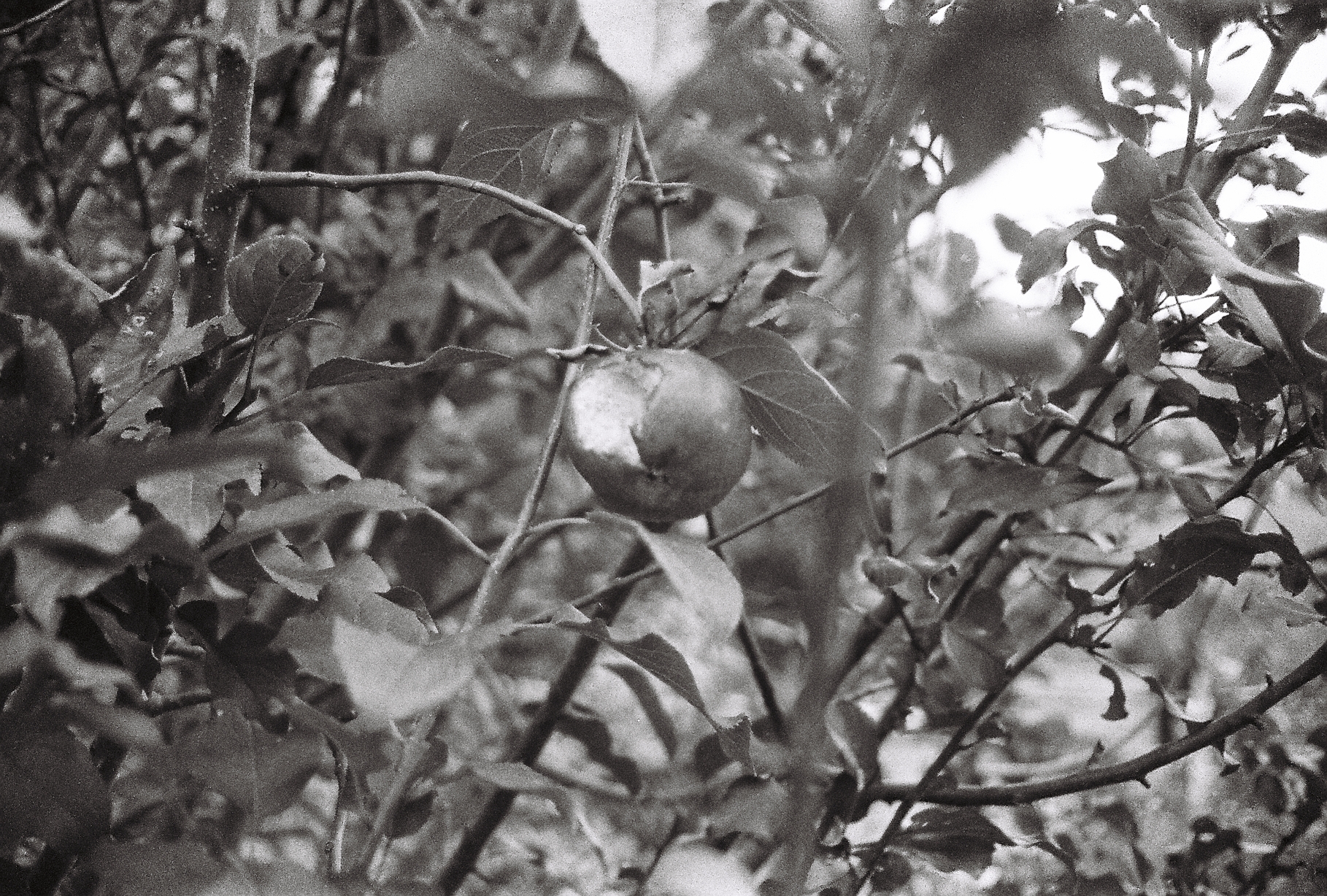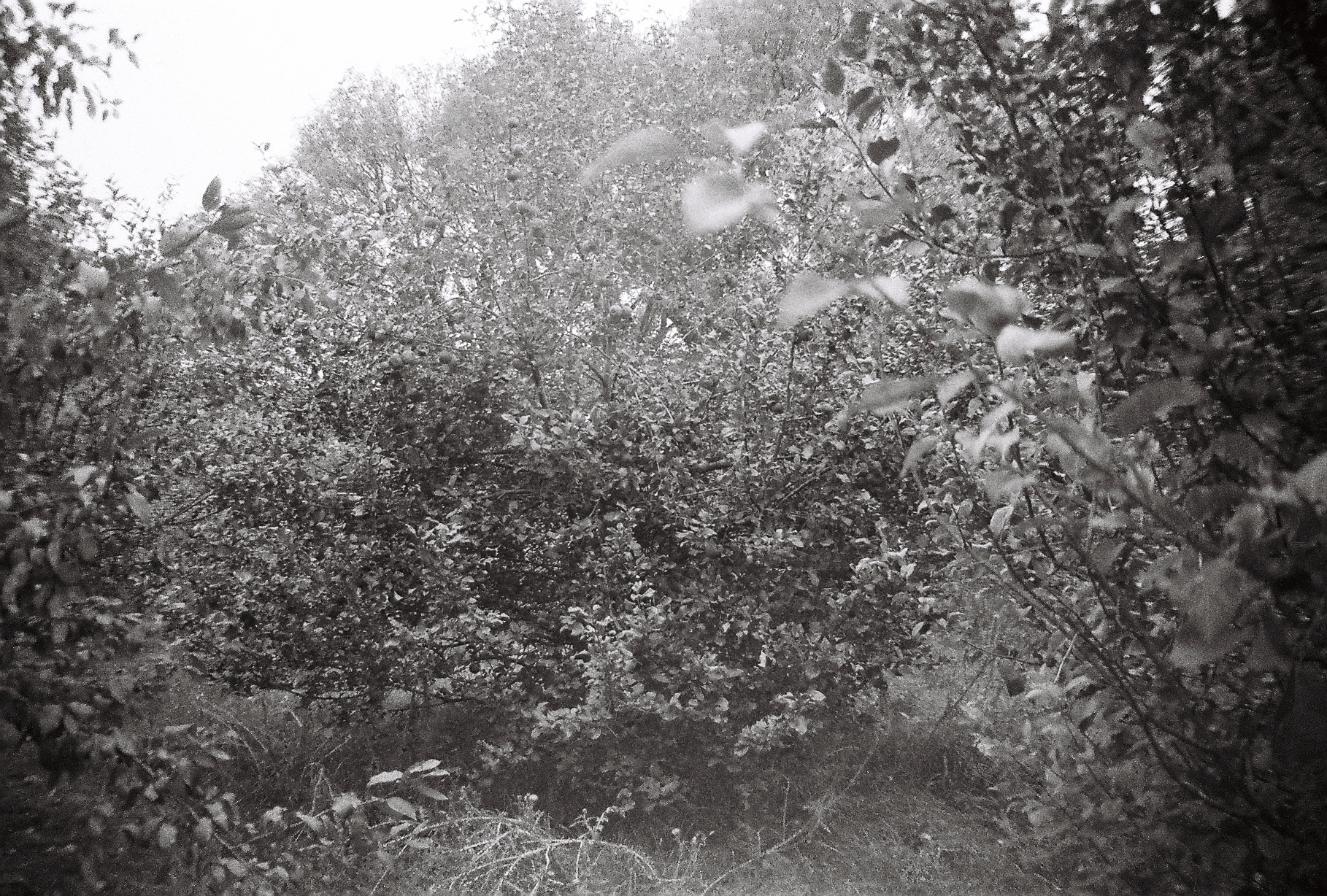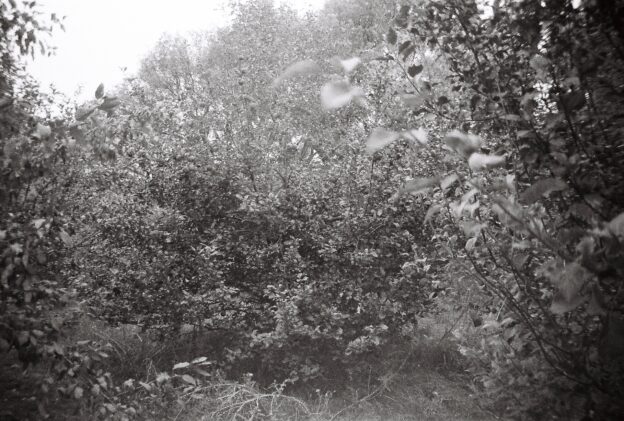with AFTER ANNIE #2 & #9
photographs by KATE HOLFORD
There’s no way to ever say this
~Rumi
“The question is swelling up in you again,” she told me in a dream, while we were walking towards who-knows-where, with a heavy, preoccupied look in her face. With the same look that he wears—based sometimes on his own perception, sometimes on my behavior, often both—when he tells me that, in her presence, I swell up. In the dream, as in the world, they both, in their spectral and physical presences, contributed to a diminished sense of liberty in my so-called real life.
I began to observe myself obsessively, leading to the opposite effect: swelling up more, diffusely. I say opposite effect because, if I set out—and to the best of my knowledge, indeed did—to observe my behavior, and attend to the supposed question lurking inside of me in such a blatant way—its very lurking repeatedly causing damage, rupture, separation—the conscious intention was to take hold of that question, to isolate it, and hopefully to mitigate its effects. Therefore, to maintain the course of our love.
Perhaps the swelling up has to do with the risk of losing it all, once again, in the vein of Austrian poet Ingeborg Bachmann’s nicht dich habe ich verloren, sondern die Welt?
The following day was completely annulled by that dream. It was replaced by a sense of shame, as if, once more, I was approaching a loss as profound as losing the love of my closest friends. Because he, my husband, is a friend, before anything else (before anything more, or less). A friend, according to my definition of friendship: a pure, condensed love, made out of innumerable gestures, words, situations, affects, actions, done or expressed for motivations that perhaps don’t seem as pure in the beginning. That is to say, friendship is, or should be (perhaps only in my idealistic mind), a wanting to be together kept afloat, and an insistence in a form of love that extends, instead of staying put, or remaining closed within any prescribed forms.
Still, imminent damage seems to encircle, and often plague, both friendships and relationships, be they romantic or otherwise. The distances erected in the form of ‘boundaries’ meant to preserve relationships often end up paradoxically splintering them. I suspect this is often the case not because these boundaries are necessarily flagrantly violated, but rather because they have taken root elsewhere, and operate on elusive terms, masquerading as conscious consensus. A notion of boundaries might be already drawn in our psyche, as in the form of thought-habits or as in the results of growing up in a specific culture, or in the form of transmitted value judgments, as tradition often infuses us with, accompanied by its characteristic utterance: that’s life.
I would have liked that a grandparent of mine had left this world with a statement that they transmitted to me in the form of a last word from their deathbed, drawing a last breath, but uttering it crystal clear: “Monogamy is an opportunity to create a loving space in one’s life that can fit more than two and less then all.” Like that, and not: “You should get married, my son, and have children, and a big family” (as it often is the case, I imagine).
I would then be able to quote them to myself, sketching out throughout my life aspects of this transmitted message, and living it with the characteristic loyalty of many of us who make a duty out of the enigmatic last words of lost loved ones. My beliefs in how we should be together, how I myself should seek out connection with others and not only my husband, to give meaning to my life, to our life together, would then have a referent, a complicitous and utterly personal guiding message.
But nobody ever told me what togetherness is or how it should be pursued. An always-failing-but-failing-better model of trial and error seems to be all there is, and the more emancipated and enlightened the society, the more clearly this model of trial and error is brandished as the only one, rather than any other.
The only consistent togetherness I lived was growing up in the family, that quintessential form of love expanding from two into more, and fraught from birth with bloodline. Condensed and pure, but inaccessible in an overwhelming way.
One Family, One Love, One . . . Madness. This form of expansion of love, the couple and the family, is tied to reproduction, however, and despite its having brought us pretty much single-handedly mankind (and overpopulation), it never fails to appropriate and rigidify the boundaries of what togetherness is, or can be.
The damage threatening this, and other forms of togetherness, seems to affect both a private and intimate life, as between two involved subjects sharing time, pleasure, life (friends, lovers, partners, fuckbuddies) and, at the same time, seems to affect everyone in the immediate vicinity, and certainly the third: the child, the friend, the lover, the partner. The stranger.
When love and its restlessness are held tight under narrowly defined norms of marriage or monogamy, love often feels like a rigged game. Should its holding patterns start to come off at their ends, say, betrayal, revelation, confession, the game runs amok. One tinkers with madness in relation to the outside world, or turns it off in self-abandonment. It’s curious to observe how monogamy, so often understood and entered into in such commonsensical terms, makes of love what over-usage does to any object: leaves it in tatters.
By the time my husband came back from the trip, she and I had already spent some days together. Had cooked, worked on the wood, partied. We also watched the same movie I had seen with him few days before he left. I recommended it, not only because it was fun, but also because it contained a scene in particular that we both liked (but not sure if we actually said so out loud). I knew she would like it too (though I’m not sure that’s what she said after watching).
I also cooked the same meal for her as I had done for him the night before he left. It might seem so, but neither did I pick the same movie, nor did I cook the same meal on purpose. I made the same choices because of a kind of amorous inertia, and perhaps also because of a lack of new ideas. One can say, I suppose, that when it comes to love, or to being in love, it’s never about newness. Rather, it’s about scrambled recollections and striking semblances.
Be that as it was, the initially slight, and then daunting, irony of these choices did not escape me, and I settled on this explanation: I chose to watch the same movie and cook the same meal for her as I did for him, because being with her felt like being with him, the only difference being that she was another person who neither had seen that movie, nor had tried that meal!
Another day, watching her carve wood, non-talkative as she often is, I felt penetrated by the same joy and lightness of being as I remembered having felt in the presence of a carpenter friend years back building boats to be sailed in Berlin’s River Spree.
The difference being, now the smell of the wood and her presence were attracting me in equal measure, a certain kind of hands-off equilibrium between mind and body rose between us, owing to a mixture of wood shavings, friendship, love, fantasy, and/or something else infinitesimally more mundane and boring. (Huckleberry summer afternoons, boys with grass straws in their mouths?) Or maybe something like Malevich’s Red Square, also aptly titled, Painterly Realism of a Peasant Woman in Two Dimensions.
In other words, we were under a languid spell of an intimate, and exhilarating, blend of feeling and thought that still manages to cause a quiet and refreshing splash in some unknown location in the space between the two of us.
After a party with her and other friends, a party full of wood and fire, I went home. Still hearing the sound of that splash the other day, I wrote to her “thank you for being around these days, you add to the happiness that already reigns in my life.” She did not respond, and perhaps did well, since I felt it was a mistake to state the obvious!
The happiness that already reigns in my life has so much to do with him. He came back from the trip energized. I will never be able to capture in words what I feel seeing him in this state: a profound pleasure at seeing him happy. The evening he came back I proposed to make burgers for dinner. I went to the supermarket and since the burger buns came in a package of four I casually thought that it’d be nice to invite a couple of friends to join us. I called to ask if he was up for the idea, and “sure,” he said, “but no big chatters, please.” I thought perhaps Lis and Lum, though they enjoy talking quite some. They couldn’t make it.
Standing in the aisle, a reflective mood set upon me. I thought: I miss so much the presence of some friends that I haven’t seen for a long time, friends with whom I can share a feeling lodged firmly in my gut, a feeling of both missing them, and of needing to share that my life has not become self-centered and defined by my coupledom. The coupled life has been—contrary to what might seem to them, or sometimes even to myself, as a life closing in on itself—hungry and capable of ever more genuine forms of togetherness, in all levels of my being.
In a city as big as Berlin, the order of the day seems always to be to turn towards and tend to your own self, a kind of mantra that knows little exception. A lukewarm mixture of wanting, but not being able to, being able to, but not wanting, spiced all over with work and family. One has no choice but to accept these gaping distances, this scattering, this virtualisation of togetherness . . . despite the fact that to accept it is to contribute to burning the ground under any true togetherness, causing those splashes in one’s heart to fall flat, instead of ripple. Closer to the supermarket counter, and still wondering how to use four burger buns as an excuse for producing more togetherness on this specific evening, I thought: she is a close friend, and not too talkative, why not invite her? I quickly remembered, however, the situations in which he would describe my proposals to see her as irrefutable proof of my obsession. I have told him that if it appears that I’m obsessed with her, in fact it is just a demonstration of love. If I love her, I love her, I love him too, and equally. (Calibrating the word “equally” is a tough piece of work that paradoxically nourishes, rather than exhausts, me.)
I have tried to show him that my love for him is insurmountably intact, my love for him is the vast pixelation that makes up the background of my happiness, like a flag I brandish invisibly inside of myself. It doesn’t occur to me to leave him, just as it doesn’t occur to me to take leave of this roundedness we call Earth.

This barrage of obsessive thoughts notwithstanding, or perhaps, because of them, I went out of the supermarket, not daring to call her, though she seemed the best choice for a dinner guest that night. Upon returning home, he exclaimed, “Ah, by the way, I spoke to her, she’s coming over for dinner tomorrow night.” All the thoughts that had so occupied me the last half an hour evaporated. I prepared the burgers, two for each one of us.
Burgers at their most intimate!
When she came over the following evening, he cooked for the three of us. While we were eating, he told her that she should check out this movie containing this particular scene. “Oh yes, I saw it with him,” she said gesturing at me, “Lovely.”
After ten days of pure love, pure struggle returned.
The struggle of differences, the struggle of egos.
The struggle between wanting to be together, and the struggle of each wanting their own way.
The struggle between fantasy and ‘the normal’.
The struggle between hidden desires and desires in plain sight.
The struggle between hetero-, homo-, and bisexualities.
The struggle between friends, lovers, and friends who wanted to be lovers.
The struggle between trivialities and ideals.
The struggle between shame and transparence.
Between spontaneity and intent.
Between vice and longing.
It is with a sense of disbelief that I write this account. On one hand, I feel compelled to recognize that something has happened. To put it preposterously: whether this is an account of a struggle in my life, or in that of the others around me, or even something that is happening to fellow persons I do not even know, seems of little importance. On the other, I do not perceive the happening in itself as being worthy of an account, despite its persistence and effects in my ‘actual’ life. It’s rather the swelling up of a question, namely, what to do with the third in any coupling that I find worthy of interrogation. It so happens that precisely the decision to pursue such a swell, or a question, is what commonly takes people to psychoanalysis, among a myriad other avenues available. (“Philosophy begins in wonder,” Socrates says in Plato’s Theatetetus, and he meant that it begins in a state of being puzzled, or perplexed.)
What to do with the third? Within this impossible account of people entangled in love, this is the provisional question I’ve chosen to articulate, that which swells in my dreams, and out of them, diffusing my attention, preventing any clarity on my experiences of love. In the same measure that I feel immensely incapable of answering this self-defeating question, I am fully responsible for its existence.
“There are fundamentally two kinds of writers, just as there are two kinds of monogamists,” [1] wrote psychoanalyst Adam Phillips:
“the immaculate and the fallible. For the immaculate every sentence must be perfect, every word the inevitable one. For them, getting it right is the point. For the fallible, ‘wrong’ is only the word for people who need to be right. The fallible, that is to say, have the courage of their gaucheness; they are never quite sure what might be a good line; and they have a superstitious confidence that the bad lines somehow sponsor the good ones.”
In art, as in life, an unfinished work, like an unresolved relationship, hangs for longer in our memory, haunting or enthusing us, constantly subject to a silent demand for closure, yet providing us with ‘nothing’ but an eternal whiff or well of potentiality in return.
The position we assume toward the world, and what we want to do with it, and ourselves in it, depends a lot on the way we use the potentiality stemming from this fundamental lack of closure in our lives. What do I do with the questions swelling up in me, as they fill me with a sense of unsolicited awareness for my state of affairs? I might, say, want to write a perfect story (even when humbly stated: all I want is simply to tell my story) or just write it with a superstitious confidence that it’ll turn out well. That is: it will justify my pursuits, whatever they are.
It’s clear that the following days had to give way to la differance. To me it’s obvious that they like each other. Attraction is never clear until it drives the nail through the flesh. For this reason, if it is attraction, I am not sure if it’s because I have charged—sometimes flooded—the friendship between us with erotic desire (or an equivalent idea of desire, often misperceived as plain desire for sex), or if it is something outside of it all, outside of me, most importantly, that has made them stand apart. But we’re all mired still in the dance of distances, never sure how well the other is really doing.
While in a monogamous relationship, to permit expression of the stirrings of the body and mind that originate elsewhere is not to violate the linings of that relationship. That’s what we so wrongly have come to believe, and so urgently need to rethink. Nor would it be to violate any other consensual relation based on boundaries. Violate just isn’t the right word. Just like no other word, not even love, can be the right word to capture states of togetherness that we so often long for.
I prefer to see this permission from another angle, away from violation: to find ways to respond to those stirrings (attractions, wantings, fantasies) within a relationship is to allow ourselves, our partners, our lovers, our friends, to get near enough to one another, touching each other first and foremost with the mind, in order to feel whether there is something in our relating that is merely a mirage, an imaginary limit, a prescribed norm turned habit of thought that might be preventing any real connection. This is not a vision of transgression for the sake of it, nor mere egotistical pursuit of pleasure, as sex in its abundant normative/non-normative availability often ends up being.

I, just like any other queer, was born into, and grown up in the outskirts of normativity, and the more of an adult I become, the farther out of reach of the center I find myself, the farther from connection with any person close to the center of the dominant discourse of what constitutes togetherness. I know countless other queers, and non-queers even farther removed from where I situate my body, my desires, with struggles more complex and often less hopeful than mine. What we all share is a search for real connection which, though hard to measure, is unmistakably felt as an urgent pursuit of a distant star.
“Without the perspective of the third, we can never have more than a partial understanding of the way that love carves its twisting course through the landscape of our lives,” writes Esther Perel in The State of Affairs: Rethinking Infidelity. Many other lessons she has accumulated from working with couples stand out as succinct insights: “Monogamy only exists in reality. It doesn’t exist in your memories and it doesn’t exist in your fantasies.” In other words, the sacred pacts of love are not so sacred after all (for those who ever thought they were), for they are either not corroborated by our pursuits of different love interests in the past, and in the present, or are a priori and a posteriori shot through by our fantasies. Perel agrees with her colleague, psychotherapist Michael Bader [2], who she quotes as saying that a good fantasy both states the problem and offers a solution.
As a queer man, at heart as well as in mind, I can’t help but drag my body through, and let its desirousness traverse, ravage the interior of my friendships, of my relationships. Therein lies the struggle: against the disciplining of the body that normativity imposes. To be queer is to moisten the dry linings of the I.
One might ask, first, how much of our culturally-sanctioned, and presumably natural, thirst for sacred love pacts, i.e., monogamous love, is influenced by figments of the triadic Sophoclean/Freudian/Oedipal structure of desire—classically, and basically: collude/identify with one parent, in order to earn the love of, and have sex with, the other, or with a combination of both—and how much of it is a free, conscious, and liberal choice, when it comes to our present preferences in love?
Can it be then that this question of what to do with the third is more of a need to keep on striving for, and at the same time achieving, this queerness at the level of the body, but without necessarily having to transform it, a Whitmanesque struggle, crackling with desire, but never giving oneself fully to the solution, no matter how possible it might seem, given one’s circumstances?
A few weekends later, in a club by the river, the music was blaring. As I stood there, deliciously falling apart, complex feelings of perfection gripped me. Every sound pierced through my body like fine needles driven through my skin. I began to imagine giant creatures trying to climb an infinite wall of ice. They hit the wall with axes made of steel, splintering pieces of the wall, while moving higher into the vertical horizon of sounds. Sometimes the axes became heels that walked through my chest that the icy wall had become. But instead of pain, I could only breath more easily, drenched in complex perfection. What I truly wanted that night was for a certain understanding to grip the three of us the same way music gripped me.
“Jealousy is a dance in which everyone moves, for it is the instability of the emotional situation that preys upon a jealous lover’s mind,” writes the poet and essayist Anne Carson, in Eros, the Bittersweet, wondering whether fragment 31 [3], a poem of Sappho, is about jealousy or something else. It turns out it’s about something else. I remember vividly the day we closely read this poem in a seminar called “Greek Thought and Literature on Education,” in winter of 2008. I was twenty, and had never heard of Carson. We were asked to compare three different translations, but my patience was thin, and I can’t recall ever understanding what the poem was really about.
Looking back, I see why Carson’s translation stayed with me. Eros is a desire as much for knowing as for the beloveds, as much for the pursuit of understanding as for the execution of a perfectly incomplete poem [4]. I would add: as much for the suturing of an open break-up, as for the slashing of a lover’s block.
“. . . what the reader wants from reading and what the lover wants from love are experiences of very similar design. It is a necessarily triangular design, and it embodies a reach for the unknown.” [5]
The somewhat timeworn psychoanalytic truism that the search for the oedipal object is going to be a permanent feature of all love relationships [6] is originally contained in Freud’s own intriguing statement that “the finding of an object is in fact a refinding of it.” [7] Otto F. Kernberg clarifies this truism in his Love Relations: Normality and Pathology:
“This does not mean understanding all future relations as deriving solely from the oedipal situation; it does mean that the oedipal structure influences the framing of new experiences for both individuals and the couple.”
When asked in a radio show what Freud meant when he suggested that “the finding of an object is always a refinding of an object,” Adam Phillips answered, “that we can only desire, or be interested in somebody, who reminds us enough of our parents, so that we can actually notice them, but not too much of our parents, so that we can actually have sex with them.” [8]
One might then ask about non-monogamous forms of love, as they find distinctive expressions in our times: can it be that our urges towards transforming monogamous love into a more dynamic and accommodating form of togetherness, i.e., breaking through the twoness of it all, have to do with particular ways in which the oedipal structure has scaffolded itself in the psyches of those able to love more than one person at a time? Can we replace or with and in friends or lovers? If we can do so without looking back, shedding rather than activating our thought-habits, this scaffolding would perhaps have something more real and lasting to prop up into fruition.
as the sweetapple reddens on a high branch,
high on the highest branch and the applepickers forgot—
no, not forgot: were unable to reach
~Sappho
[1] Phillips, Adam. Monogamy. Vintage, 1996.
[2] Bader, Michael. “The Secret Logic of Sexual Fantasies.” Mysteries of the Mind, 31 Jan. 2019, https://michaelbader.com/mysteries-of-the-mind-episode-7-the-secret-logic-of-sexual-fantasies/.
[3] Anne Carson’s translation is considered the most faithful and is to be found here among 34 other translations.
[4] Carson, Anne. Eros the Bittersweet: An Essay. Princeton University Press, 2014, pp. 49.
(see also pp. 218-223)
[5] —. Eros the Bittersweet, pp. 148.
[6] Bergmann, Michael S. The Anatomy of Loving: The Story of Man’s Quest to Know What Love Is. Ballantine Books, 1987.
[7] Freud, Sigmund. Three Essays on the Theory of Sexuality. Translated by James Stratchey, Basic Books, 2000, pp. 88.
[8] “Adam Phillips Gives Praise to the Unlived Life.” The Leonard Lopate Show, 26 Feb. 2013, https://www.wnyc.org/story/272025-adam-phillips-gives-praise-unlived-life/.
[9] Sappho. “Fragment 105a.” If Not, Winter: Fragments of Sappho, translated by Anne Carson, Vintage, 2002.
SOKOL FERIZI writer
Sokol Ferizi is a writer, poet, and translator based in Berlin. His work includes a book of poems, In a World Without Germany We Could Be So Good Together, and contributions to magazines such as Starship, Havenot, The Moth, and 212, as well as zines such as Lirindja, Kushtetuta, and Lamella. He is Contributing Editor and Staff Writer at Stillpoint Magazine.
KATE HOLFORD artist
Kate Holford is Art Director of Stillpoint Magazine, and an artist and curator based in Glasgow.
AFTER ANNIE #2 & #9 (2018) are from a series of photographs taken in Fergus Falls, Minnesota. It is from an ongoing collaborative research project with Editor Anne Marie Wirth Cauchon.
© Copyright for all texts published in Stillpoint Magazine are held by the authors thereof, and for all visual artworks by the visual artists thereof, effective from the year of publication. Stillpoint Magazine holds copyright to all additional images, branding, design and supplementary texts across stillpointmag.org as well as in additional social media profiles, digital platforms and print materials. All rights reserved.



